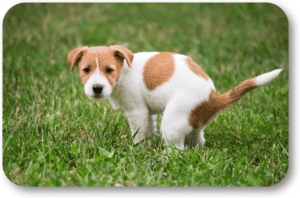I was at a Home Dog Training session last Monday in Cumming working with a new dog training client and his nine-month-old German Shepherd named Storm. At nine months of age, Storm is now leaving his puppy phase and starting to become a young teenager or “tweenie”. As with “human tweenies” he is beginning to become more physical (because of his size) and more inwardly focused. My client understood that the one thing you don’t want is a strong, self-centered Shepherd.

After working with my client and Storm for a few hours, Storm learned that inappropriate physical actions were unacceptable and that he should pay full and respectful attention to my client. As I was finishing up, I asked if there were any other issues that my client was facing with Storm.
My client said that, for the most part, Storm was pretty much potty trained. He didn’t make very many accidents at all and that made my client and his family very happy. There was one weird thing though. There have been times where he had Storm out for a long potty break and Storm didn’t have to go. Within minutes of coming back inside, Storm would have a potty accident. Although this didn’t happen very often, he wondered if he could fix this small potty issue.
Believe it or not, this is a very common issue that many puppy owners experience. They take their puppy outside and give them all the time in the world to “do their business”. From every indication, it appears that they do not have to go potty. They direct the puppy back into the house, the puppy willingly goes back inside, and in a matter of minutes potties on the carpet.
I told my client that, although pottying is a “natural, physical event”, it still needs to be passively managed in order to happen. This means that my client needs to focus on appropriate behavior, specific locations, and analytic observation in order to be successful in having his puppy go to the bathroom when outside. Although all of this sounds like “a lot of stuff to worry about”, it really isn’t and can be easily solved. I offered the following suggestions that we offer all our clients facing this similar problem:
- It is very important that you get your puppy energetically active the moment you take him outside for his potty visit. Quite simply, you want him to “play like a puppy”. Engage him in activities such as throwing the ball and having him chase after it. You may get several balls so that as soon as he reaches one ball, you throw another ball in the opposite direction. The purpose of this activity, or any activity you pick, is to get him running and increase his metabolism. This is the first step in encouraging “potty”.
- Next, in the height of all the running and jumping and playing, simply stop. Do nothing; stand still; remain calm and disengage. Your disengagement in all the “playtime actions” will cause him to slow, have his rate of metabolism decrease and relax his muscles. You will now see him start to become more interested in the sights and smells around him. He will start to sniff around. This is the next step that naturally encourages a potty event.
- After a moment or two of “being calm and sniffing”, he will normally potty #1. After this takes place, he will become slightly more animated as he continues to move around the yard, sniffing as he goes. He will often find a location in the yard away from you and begin to circle. After about ten to twenty seconds, he will stop and potty #2. As soon as he finished this, he will normally become more animated and often “appear to be happy he just did a poopie”.
- At this point, many people simply call their puppy back inside. Do not do this. Let him hang outside for a bit after he has completed his #1 and #2. This is because many puppies need to do a #1 or #2 again. In other words, they might not be done just yet.
- Let your puppy “hang outside for about another five minutes”. I have found that if your puppy “needs to go again”, he will potty within this timeframe.
- If you have been outside for about fifteen to twenty minutes and your puppy hasn’t pottied, bring him back inside. When inside, keep him on a leash next to you. Wait for about five to ten minutes and then take him out again. Quite often the act of coming inside will heighten his urge to potty.
Potty training is not done by waiving a magic wand and saying Abra Cadabra. It is successful when you put a repetitive, manageable, and observable process into place. That is “the magic” to successful potty training.
Please call or text us at (770) 718-7704 if you need any dog training help. You can also email us at [email protected]. We are blessed to have been your local dog training experts for over nineteen years. We have trained over 6,000 wonderful dogs and superb families and are ready to help you.

Follow Us!